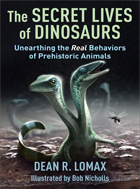Paleontology (from the Greek paleo,"ancient"; ontos, "being"; and logos, "knowledge") is the study of ancient life -- from ferns, to fish, to ferrets, to formations -- and of the fossilised evidence they have left behind.
People who study paleontology are known as paleontologists, and from the highest mountains to the deep blue sea nowhere is safe from these fossil crusaders who, more often than not, are as colorful as the critters they study. But there's more to paleontology than just digging up bones.
Paleontologists also study fossilized tracks and burrows, trees and shells, coprolites (fossilized poop), and rock layers, their age, and the age of the remnants they preserve. The real research begins after the initial discovery and a sound knowledge of current life forms - to compare ancient flora and forna to, is always a bonus. As is a Hercule Poirot-like knack for sniffing out clues that will help them recreate what life on earth (and the earth itself) was like in the ancient past, how organisms evolved, and how they interacted with each other and their environment.
You may think paleontologists and archaeologists are the same, but they are very different. The former specialize in the study of fossils, while the latter focus on human artifacts and remains.
Click here to view Dinochecker's Good Paleontologist Guide.
People who study paleontology are known as paleontologists, and from the highest mountains to the deep blue sea nowhere is safe from these fossil crusaders who, more often than not, are as colorful as the critters they study. But there's more to paleontology than just digging up bones.
Paleontologists also study fossilized tracks and burrows, trees and shells, coprolites (fossilized poop), and rock layers, their age, and the age of the remnants they preserve. The real research begins after the initial discovery and a sound knowledge of current life forms - to compare ancient flora and forna to, is always a bonus. As is a Hercule Poirot-like knack for sniffing out clues that will help them recreate what life on earth (and the earth itself) was like in the ancient past, how organisms evolved, and how they interacted with each other and their environment.
You may think paleontologists and archaeologists are the same, but they are very different. The former specialize in the study of fossils, while the latter focus on human artifacts and remains.
Click here to view Dinochecker's Good Paleontologist Guide.
Recommended reading
• Benton MJ (2016) "Dinosaurs Rediscovered: The Scientific Revolution in Paleontology".
• Benton MJ and Harper DAT (2020) "Introduction to Paleobiology and the Fossil Record".
• Marcelo R. Sánchez-Villagra and Orangel A. Aguilera (2010) "Urumaco and Venezuelan Paleontology: The Fossil Record of the Northern Neotropics (Life of the Past)".
• Lomax D and Nichols B (2021) "Locked in Time: Animal Behavior Unearthed in 50 Extraordinary Fossils".
• Stuart AJ (2022) "Vanished Giants: The Lost World of the Ice Age".
• Benton MJ (2014) "Vertebrate Palaeontology".
• Prothero DR (2016) "The Princeton Field Guide to Prehistoric Mammals".
• Edmeads B (2021) "Megafauna: First Victims of the Human-Caused Extinction".
• Doyle P (1996) "Understanding Fossils: An Introduction to Invertebrate Palaeontology".
• Martin AJ (2015) "Dinosaurs Without Bones".
• Bromlery RG (2016) "Trace Fossils: Biology, Taxonomy and Applications".
• Wignall PB (2017) "The Worst of Times: How Life on Earth Survived Eighty Million Years of Extinctions".
• Wiewandt T (2021) "Fossils Inside Out: A Global Fusion of Science, Art and Culture".














